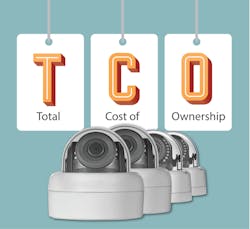This article originally appeared in the May 2022 issue of Security Business magazine. When sharing, don’t forget to mention Security Business magazine on LinkedIn and @SecBusinessMag on Twitter.
Before an organization can realize a possible return on investment (ROI) for its video security systems, they must first fully understand the total cost of ownership (TCO).
Too often, end-users make snap decisions about product selection based on a handful of specs they gleaned from a data sheet. And then, of course, there is the “lowest price” consideration, which is often calculated by only three factors: price of hardware, installation and activation, and monitoring.
Total Cost of Ownership is rarely a consideration; however, over the life of the product – or even a budget cycle – customers can save money, achieve better results, and ultimately have more confidence in their integrator when TCO is something that the integrator promotes right from the beginning.
When it is time to replace or upgrade an integrated security system, or work with end-users to evaluate options, make factoring in the TCO part of the process. As with any sophisticated technology, the purchase and installation costs are just the beginning. Failing to budget for other costs that are part of the security process can lead to system deficiencies and malfunctions, causing the end-user to incur more costs.
TCO Defined
Total Cost of Ownership refers to the purchase price of an asset plus the operation costs. To determine TCO, take the capital expense (CAPEX) and add the operating expense (OPEX) required for the day-to-day functioning of the system. The TCO is used to calculate the total cost of purchasing and operating a technology product or service over its useful life, and it is important for evaluating technology costs that are not reflected in upfront pricing.
For a holistic surveillance system, TCO includes everything, from the hardware (cameras and access control equipment) to video management software, network resources, ongoing maintenance costs, and salary for employees working on the project. These factors must all be considered when selecting the best solution for your organization.
For any security system, TCO is a huge differentiator. Typically, the expenditure differences between like and competing products can fluctuate significantly; however, because of the rapid advancement in security and cloud-based technologies, the TCO difference between competing products can be even more significant. Though the “upfront” pricing may be comparable, the cost to deploy these solutions and keep them functioning optimally throughout their lifespan may be quite different.
Today, TCO is increasingly becoming an important factor in helping clients see that the lowest-priced system may not be the most economical to own and operate long-term. There are several considerations integrators can point to when helping customers decide on a solution that will have a lower TCO over its lifespan; in fact, after 5-10 years, the end-user’s TCO could conceivably be ~50% lower from one manufacturer to another when the integrator helps them understand the importance of these critical factors.
Annual/Mandatory Upgrades and Licenses
A purchase decision is not just about up-front CAPEX costs, but also long-term costs. This can be challenging to understand and quantify at the initial purchasing stage. Often, it is only after customers have invested in the system and started using it that they realize the importance of these long-term, ongoing costs.
There can be ambiguities in how companies market their products, and integrators need to do their homework upfront to understand the potential subsequent licensing fees. Just because a camera “can” do a particular list of things does not mean customers will not be required to pay separate fees for each one of those extra features.
Many manufacturers change annual licensing fees for software behind the scenes. Integrators need to investigate and consider these things, and those promoting TCO need to be able to present the value proposition. Answer the following questions to help do that most effectively:
- Does the manufacturer require mandatory upgrades? Not all customers will be interested in the features offered in every upgrade.
- Do they offer upgrade protection plans (UPP)? UPP subscriptions are very affordable, especially when you evaluate the risk of not having one.
- Is the manufacturer’s upgrade program based on a hardware and software footprint, or is it based on the number of licenses? Customers will save money in the end if they are not being charged based on the number of cameras, recorders, servers, VMSs, etc.
- Do the licenses expire? Do they become obsolete as the platform gets upgraded? If a customer purchases a system with a set number of licenses and wants to add five more licenses, do they have to pay for a full-on upgrade and then buy licenses for that version?
- Are the licenses tied to a MAC address, which prevents customers from switching cameras?
- Do customers have to retro-pay for every “version” upgrade since the last time they upgraded the system, or is there a one-time maintenance charge per system? Many manufacturers require customers to pay for all the versions they “skipped.”
- If, after the initial purchase, a customer is looking for special functionality, is that functionality included in the initial licensing, or will they incur additional costs?
Tech Support Cost and Availability
Though rarely factored in, the costs and availability of tech support ultimately play a huge role in TCO. End users need to think about the cost of their own time and what they are not doing while dealing with tech support issues. They should be encouraged to consider these factors:
- Does the manufacturer charge a subscription fee for their tech support resources? These fees can impact a company’s OPEX over the lifespan of the system.
- Can an end-user reach out directly to the manufacturer for basic questions, or do they have to go through their integrator no matter how mundane the question/issue is? This can put quite a burden on integrators.
- How easy is it to get through to tech support? Time is money; no one should have to sit on hold for extended periods of time or wade through convoluted auto attendant menus.
- Where is the tech support facility located?
- Is the tech support offered 24/7? Not all tech support issues occur during working hours!
- Is it just a “knowledge database,” or will callers get to interact with a real person? It is no mystery that speaking with a live person can expedite resolution.
- How quickly do issues get resolved (demand their stats)? In mission-critical situations, there can be a huge monetary implication between a two-hour vs. two-day resolution.
- Can tech support remote into the system directly for faster resolution?
Proactive Health Monitoring
Proactive Health Monitoring is another important consideration as it provides the ability to address issues before they become problematic and costly. Robust health monitoring should provide proactive notification to system administrators before a complete system failure and notify them about potential system issues within seconds.
Consider what the health dashboard proactively monitors, and ensure the end-user has easy access to all system components and network status. Also, look for a true diagnostic tool that is easy to read and diagnose. If the health monitoring interface is too convoluted, system administrators will be less likely to monitor it which can have devastating consequences.
Factory Warranty Terms
Apples-to-apples, customers are often tempted to go with the less expensive products. For example, two cameras are 2MP, and the customer chooses the one with a lower purchase price. Often, one of the factors contributing to a cheaper camera is its factory warranty terms, which are typically lesser than the warranty on the higher-priced camera.
The bottom line? It comes down to which is more cost-effective: a cheaper camera with no warranty, or a similar (yet slightly more expensive) camera with a more extended warranty? All technology is subject to wear and possible problems, and when problems occur, more extended warranties may save money. Responsiveness to warranties is also crucial, as a failed system may leave a dangerous and costly gap in the security plan.
Integrators should work with their customers to better understand the terms of the manufacturer's warranty. This should include understanding whether the manufacturer offers the option for advance replacement vs. repair-and-return. Customers should be able to choose which they prefer.
Other considerations:
- Does the customer have to issue a PO before receiving the replacement? They should not have to do that.
- Does the manufacturer incur all shipping costs – both ways – for Advance Replacements? They should!
- How long are out-of-box failures covered? Make sure it’s at least 30 days.
When a manufacturer can deliver these warranty terms, it is a good sign that they have confidence in their product, and the integrator and customer can too.
Training
One of the final elements to consider is training. A quality training program can make or break the customer experience and ultimately get the most from their investment. Ensuring that the manufacturer offers free basic training for customers and integrators is important. Some manufacturers offer more in-depth training for a fee, and that is fine, but make sure the basics are covered at no additional cost.
Bret McGowan is SVP of Sales and Marketing for Vicon. Request more info about the company at www.securityinfowatch.com/10215670.



